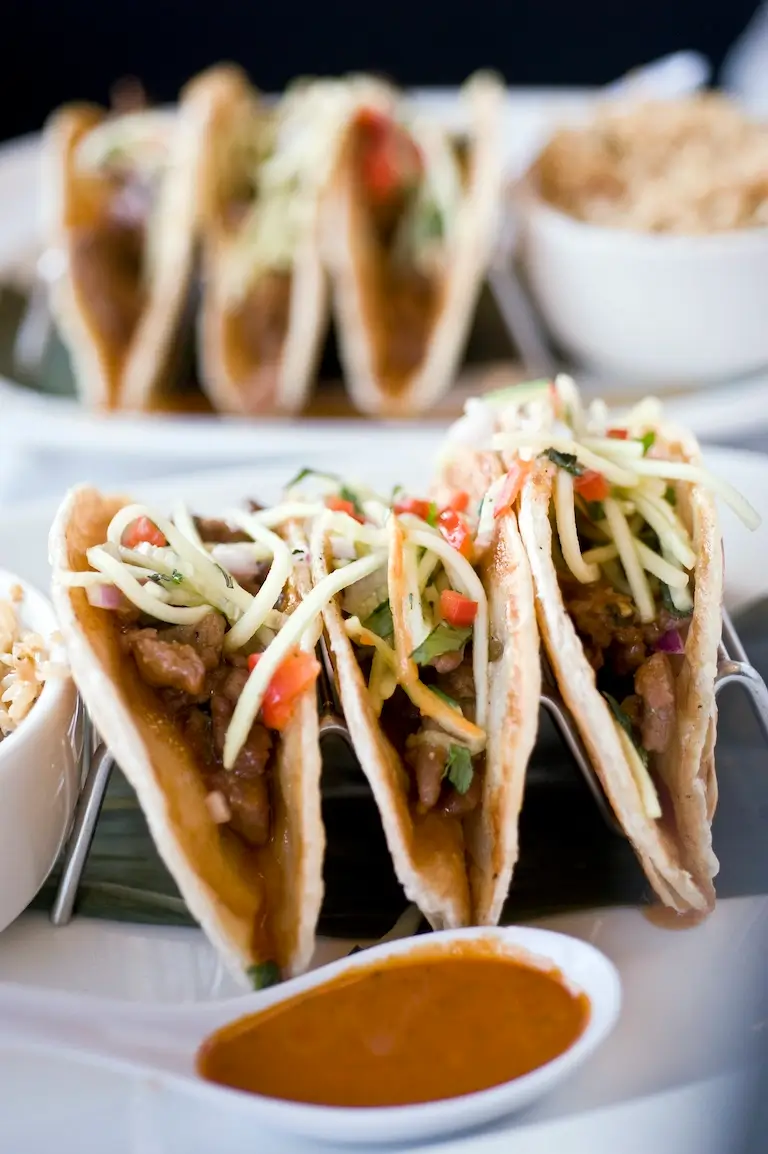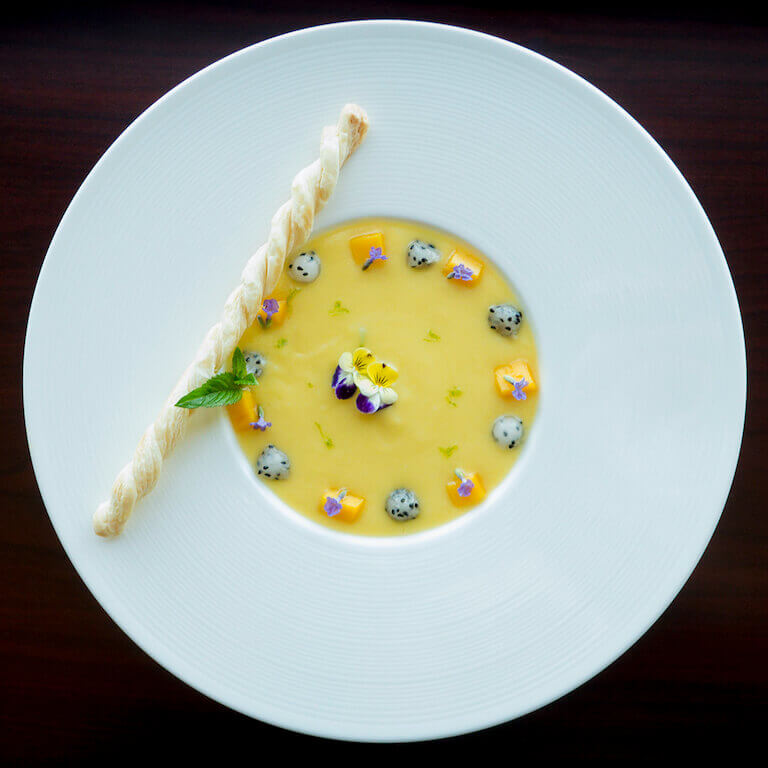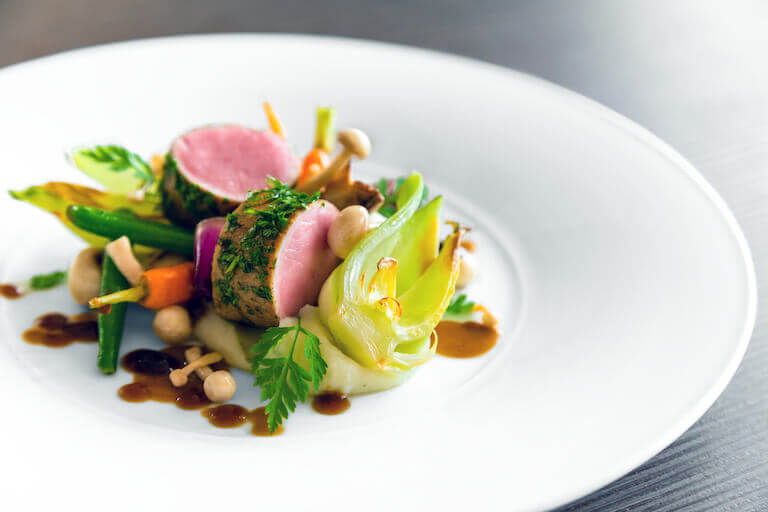Listen to This Article:
Fusion cuisine is popping up all over the culinary world, including on restaurant menus and conversations among food enthusiasts. But what exactly is it?
At its core, fusion cuisine is a blend of ingredients, techniques, and flavors from different cultures and culinary traditions that creates something entirely new. While the term may be growing in popularity, it’s not just a modern trend. Fusion cuisine has been a part of global cuisine for centuries.
Let’s look at the history of fusion food, its evolution, and what we might anticipate in the future for this ever-changing culinary style.
What Is Fusion Cuisine?
Essentially, this catch-all term means bringing together ingredients from different cultures and merging recipes. This technique of joining culinary forces offers truly novel flavor combinations and unique menu offerings that customers can’t find elsewhere.
A few popular examples include:
- Butter Chicken Poutine – A Canadian-Indian fusion where butter chicken is served over French fries and cheese curds.
- Korean Tacos – Tacos filled with Korean BBQ-style meat, kimchi, and spicy gochujang sauce.
- Sushirrito – A hybrid of sushi and a burrito, often using fresh fish and spicy mayo in a sushi-style wrap.
- Buffalo Chicken Spring Rolls – A fusion of Chinese spring rolls and American buffalo chicken flavors.
Fusion food has a complex history whose origins can’t be easily pinpointed. It has likely been around for centuries, as long as humans have been exchanging facets of their culture.
Many dishes we know today as belonging to a certain culture actually originated from an entirely different family of cuisine. For example, spaghetti is now believed to have been perfected by Chinese chefs before ever making its way to Italy. In fact, tomatoes were only added to European cuisine after colonizers reached North America.

Korean tacos are an example of fusion cuisine, which brings together flavors from different cultures, creating unique dishes.
French chefs in larger cities started combining Asian foods in some of their dishes in the 1970’s, beginning the Asian fusion movement so widely popular today. These chefs found the bolder spices of particular Asian cultures – typically Chinese and Vietnamese – to balance the creamy richness of their dishes, which were heavy on cheeses, doughs, and oils.
Chinese-American fare has been around for quite some time and is perhaps one of the longest-standing examples of fusion cuisine in the U.S. It’s thought to have originated in San Francisco in the late 1800’s, as Chinese foods in the U.S. were modified to suit the middle class American palette.
One of the earliest Chinese dishes to be “Americanized” was chop suey, a combination of meat, eggs, and vegetables that can be cooked and served to hungry patrons relatively quickly. What many Americans consider to be “Chinese food” would likely never pass the test of authenticity in China. General Tso’s chicken, crab rangoon, egg foo young, orange chicken, and fortune cookies are just a few of the items you’d likely not find on a Chinese food menu in China.
Popular Types of Fusion
- Tex-Mex: this type of cuisine is a blend of traditional Mexican foods like beans, meats, and cheeses with Texas-inspired cooking methods, like frying tacos so that they’re crispy.
- Cajun: hailing from the bayous of Louisiana, this French-inspired cuisine popular in the American South includes pork and crawfish bases with heavy seasonings.
- French-Vietnamese: among other Asian fusion menu items, the ever-popular sandwich known as the bánh mì includes Vietnamese pork sausage and veggies on a French baguette.
- Indo-Chinese: taking aspects of Indian food like vegetables and spices, merging them with Chinese sauces, and cooking them in a wok, makes this family of cuisine a winning combination.
- American sushi: offerings like the California roll have classically American ingredients like mayonnaise and avocado, served via a decidedly Japanese makizushi sushi roll.
Tips for Fusion Cooking
Mixing cuisine styles takes incredible finesse and a proficient understanding of the individual types of cuisines on their own to start. Let’s look at some of the ways culinarians can be successful at making fusion foods.
Know the Culinary Basics
True innovation requires a firm foundational knowledge. Going to culinary school for an education – whether in the form of a degree or diploma, or through on-campus or online coursework – can help you navigate the kitchen more adeptly, decreasing the effort spent figuring out basic tasks and increasing the time you have to get creative with your ingredients.
*Information may not reflect every student’s experience. Results and outcomes may be based on several factors, such as geographical region or previous experience.
Do Your Research
Fusion cuisine calls for passionate experimentation but also a thorough understanding of which flavors and mouth feels pair best together. Research is an important piece of the puzzle with fusion cuisine. Knowing your ingredients inside and out can help you make the right combinations and avoid making something truly inedible.
Research chefs like Robert Danhi specialize in doing deep research on global cuisines and then experimenting with flavor profiles to create something unique.

Researching global ingredients and flavor profiles helps chefs create unique fusion dishes, like this cold fruit soup garnished with edible flowers.
Be Willing to Try New Things
This is often the most fun part for crafty culinarians! Trying out new combinations and seeing what works – and what doesn’t – is at the heart of fusion cooking. After all, who would think Korean BBQ chili or a s’mores taco would be a hit? The key is in the experimentation!
Accept Failure as Part of the Process
Of course, trying necessitates occasionally failing. If you’re breaking into the world of fusion foods, you’re going to have quite a few flops along the way. Simply put, not everything that you think will pair well together will actually pair well together.
Instead of beating yourself up over a failed dish, consider it a learning opportunity. Assess where the mistakes happened – did you use the wrong seasonings? Did you try to mix savory and sweet in a way that didn’t work? Did you miss the mark on texture when you focused too much on flavor?
Keep in mind that you can learn as much from a failure as you can from a success.
*Information may not reflect every student’s experience. Results and outcomes may be based on several factors, such as geographical region or previous experience.
Latest Trends in Fusion Cuisine
When food fusion entered the mainstream in the 1990s, many chefs prioritized shock value over flavor, opting for unexpected ingredient pairings that didn’t always complement each other. This led to less than stellar results, which discouraged some chefs – and diners – in terms of fusion food. An understanding of what’s truly important in terms of fusion cuisine, taste as opposed to novelty, can serve current and future chefs well as they look to develop their own recipes.

Modern fusion cuisine focuses on balancing bold flavors and effective combinations, creating refined dishes like this elegantly plated fusion-inspired meal.
Thankfully, present-day fusion has continued to evolve and is about embracing bold global flavors and unexpected ingredient pairings that work together. For example, dumplings have become a favorite canvas for fusion. Birria dumplings combine the rich, slow-braised Mexican stew with Chinese-style dumpling wrappers.
The rising popularity of bold global flavors has also led to reinvented classic comfort foods. One exciting creation is gochujang mac and cheese, where the spicy, fermented Korean chili paste adds a deep umami kick to the classic comfort food. Meanwhile, paneer sliders give a twist on the American burger by swapping the beef for spiced Indian paneer, paired with chutney and a soft brioche bun.
Fermented foods are also hitting the fusion scene, with ingredients like kimchi and miso being used with everything from pasta sauce to grilled meats, adding complexity to familiar dishes.
Context is vital when it comes to a successful fusion recipe. If you know what the customer base at your restaurant enjoys and can create fusion recipes accordingly, you’re off to a great start. As the world continues to “get smaller” through advances in transportation, technology, and accessibility to regional ingredients, fusion restaurants are cropping up in many places. The career avenue of fusion cuisine is one to watch across the global melting pot.
Explore Fusion Cuisine and More
There are myriad opportunities to participate in the world of fusion cuisine, either in an existing fusion establishment or by experimenting with unique combinations in your own kitchen. We’ve looked at some guidelines for building fusion recipes, including a willingness to experiment, recognize failures and adapt, as well as incorporating your own favorite ingredients into the mix.
A firm grasp of culinary skills goes a long way toward developing effective, appealing fusion dishes. Auguste Escoffier School of Culinary Arts can offer students the chance to develop their abilities under the close tutelage of experienced professional chefs, both in terms of their work directly with food and the many business and managerial aspects of being a professional chef. Contact us to discover how our programs can help you build a strong culinary foundation and bring your unique culinary creations to life.
WANT TO LEARN MORE ABOUT TRENDS IN THE CULINARY INDUSTRY? READ THESE NEXT:
- A Guide to Italian Cuisine: Its History, Flavors, and Influence on American Cooking
- Plant-Based vs. Vegan: Why Chefs Need to Know the Difference
- French Cooking: How and Why French Cuisine Came to Rule the World
This article was originally published on October 3, 2019, and has since been updated.
*Information may not reflect every student’s experience. Results and outcomes may be based on several factors, such as geographical region or previous experience.

